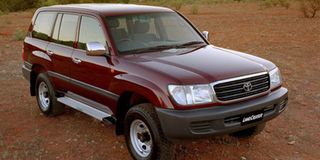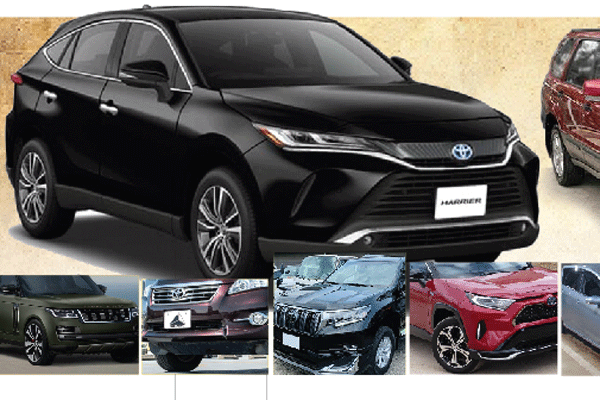All about the Toyota Land Cruiser 100

What you need to know:
The Land Cruiser’s 100 Series is larger overall than earlier models. Weighing in at around 2.5 tonnes, it is perfect for heavy towing but is heavy on fuel.
I recently laid eyes on a short film in which a brand new German saloon (three-pointed star, no less) was being driven more sideways than forward through a goat path that can best be described as “barely tractable”. That is when you see the much-vaunted 4Matic all-wheel drive system at work (though full disclosure; off-roading was not the intended purpose of the 4Matic system in the German saloon).
I have a friend with yet another German saloon, also with a three-pointed star, and I made use of his vehicle as the lead car for the recently concluded Great Run XVIII. Part of that usage involved a short hop from Lodwar Town in north-western Kenya to Eliye Springs, a remote village on the western shore of Lake Turkana in Kenya, a road that we were told needed Land Cruisers courtesy of its sandy consistency.
Well, that German saloon made the trip without qualm, including an attempted rescue mission of a Subaru that got stuck. Why did the Subaru get stuck? It was rescuing yet another German saloon (three-pointed star, no less, would you have guessed?) that was already stuck, and the Subaru started digging before beaching itself hopelessly. I am starting to think this may be a driver issue.
German SUVs?
There is only one; the Gangster-mobile, the Gelandewagen. They cost too much though, but they will go places and do things no other 4x4 can, not even the heavily celebrated Land Rovers and Landcruisers.
Speaking of Land Cruisers; the 1HD-powered 100 Series is quite literally my dream car, but soaring prices have pushed me towards the 200 Series. For the same price you get a lot more substance... not “substance” in terms of quality, literal substance. The 200 is much bigger and much heavier than its predecessors. I will issue a disclaimer here and declare openly that I am discussing a well-kept 100 Series diesel versus a well-worn 200 Series petrol when I refer to similarity in prices.
But we are comparing apples to apples, no? Diesel vs diesel. Let us start off with the fact that for the price of one 200 Series diesel, with the incredible 1VD V8 engine, you can avail yourself of two very well kept 100 Series, both with 1HDs. Diesel-powered Toyota SUVs are expensive, irrespective of age.
The 200 Series is bigger and heavier than the 100, and this shows in the performance and handling. The 200 may have a V8, but it uses up to six of those eight cylinders just lugging itself around, leaving the remaining two to handle acceleration tasks. It struggles with obesity.
Handling
That obesity is also felt in the handling. The driver is isolated from anything going on around them and the 200 handles like a schooner, but of the few 200s I have driven, none had AHC (Active Height Control, aka “air suspension”). Perhaps the ones fitted with AHC drive better. Braking is also a problem.
The weight of the 200 means it eats brake discs, and if you dabble in spirited driving, one of the recommendations is to do an upgrade soon after purchase for peace of mind. The size of the 200 makes it a tad bit intractable. It is difficult to park and unpark, and I recall writing “children could die in the path of a reversing VX” if your vehicle is not equipped with a reversing camera.
The blind spots are huge, and as a guest driver, the dimensions take some getting used to. Parking lot dings may be collected on a high frequency if you are impatient. This size also compromises off-road ability if your path involves jungles and tight turns.
However, the 200 is the evolution of the 100, so it carries more tech while still toting Toyota’s legendary reliability (the brakes, though).
The higher trim models come with AHC (which was also available on the top spec 100s) as well as KDSS, the Kinetic Dynamic Suspension System, a trick-trick setup that adjusts front and rear stabilisers through a series of interconnected hydraulic lines and cylinders. The best part of the 200 Series is the 1VD-FTV turbo diesel V8 engine.
The 100?
Time has been kind to it. It still looks handsome, it will not attract the wrong kind of attention like the 200, it is fast enough for most of your needs and a simple chipping of the engine unlocks hitherto untapped levels of performance (I drove a chipped one to Lake Ellis earlier this year and my son begged me to buy that vehicle from its current owner when I picked him from school in it), it will go anywhere without breaking, it handles well enough, does not show its weight and I think I just answered my own question.
Why is the 100 becoming more expensive? Reread this paragraph.
The petrol versions of both are the compromise. You get most of the same benefits but you trade in buying price for fuel economy.
The petrol versions are much cheaper than the diesel units, but they do have a thirst that can turn fearsome in short order. The 200 petrol is especially terrible at this, burning fuel at an alarming rate without a corresponding crescendo in outright velocity.
Service
Service it religiously, use the right oils and fuels and do not mistreat the turbo, that engine will probably run long after Skynet has eliminated mankind.
Warm up the engine after a cold start before hightailing it out of the parking lot, allow the turbo to spool down after a hard run or a long jaunt before shutting down, and you will enjoy your Land Cruiser until kingdom come.
Before buying
The Land Cruiser is bought by most people to work hard, so look for wear on the interior trim and general lack of care around the car such as dings and dents on the body.
Inspect the underside of the vehicle for damage through offroad use.
Also look for bashed and beaten underbody fittings such as brackets, fuel tanks, suspension components, and the underbody itself. Inspect all drive-line joints for broken seals that could have let water into the joints. Check for a service record and have a specialist check done before purchase.





